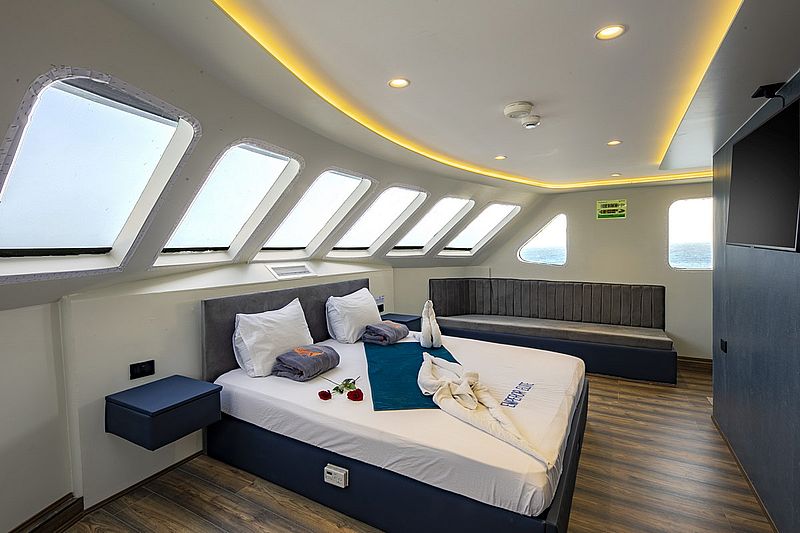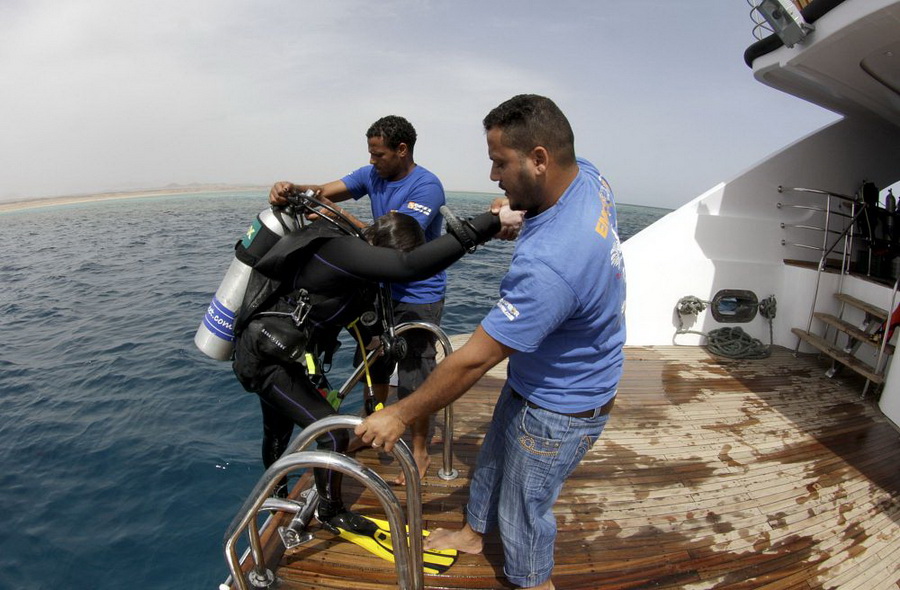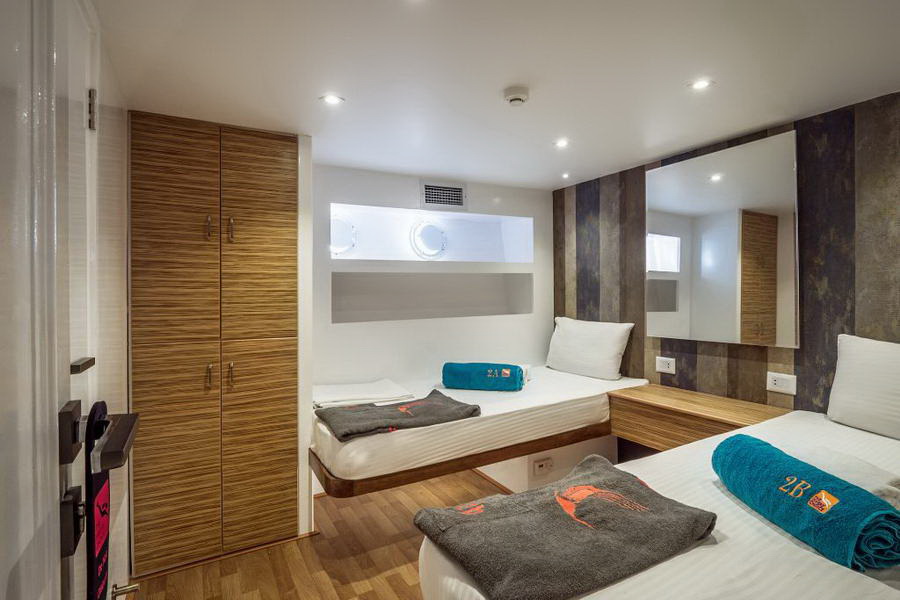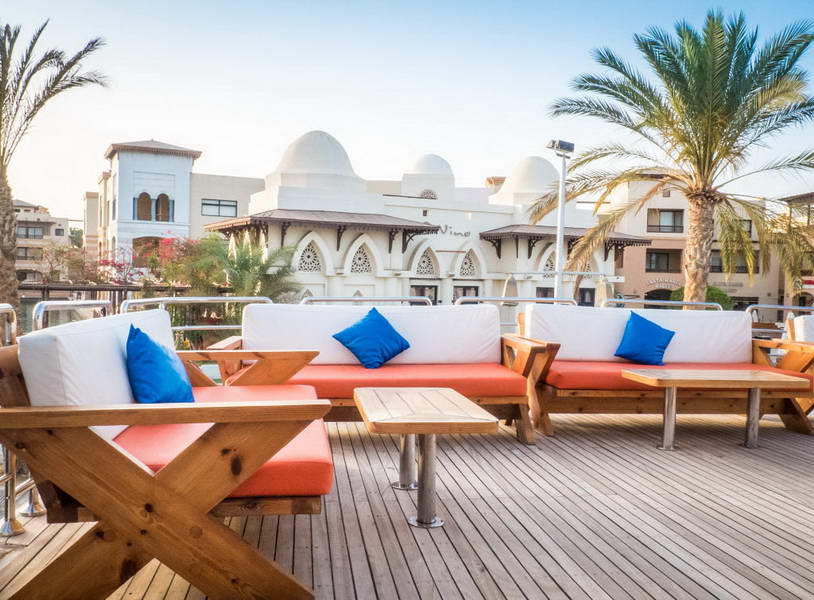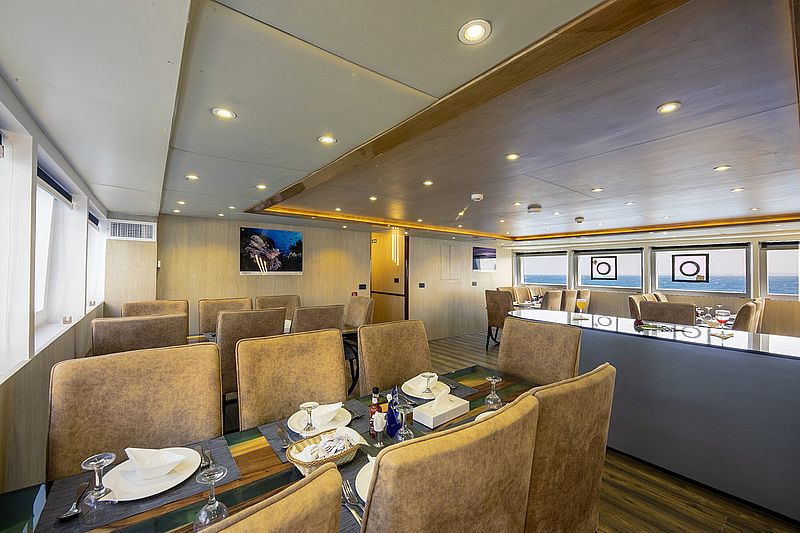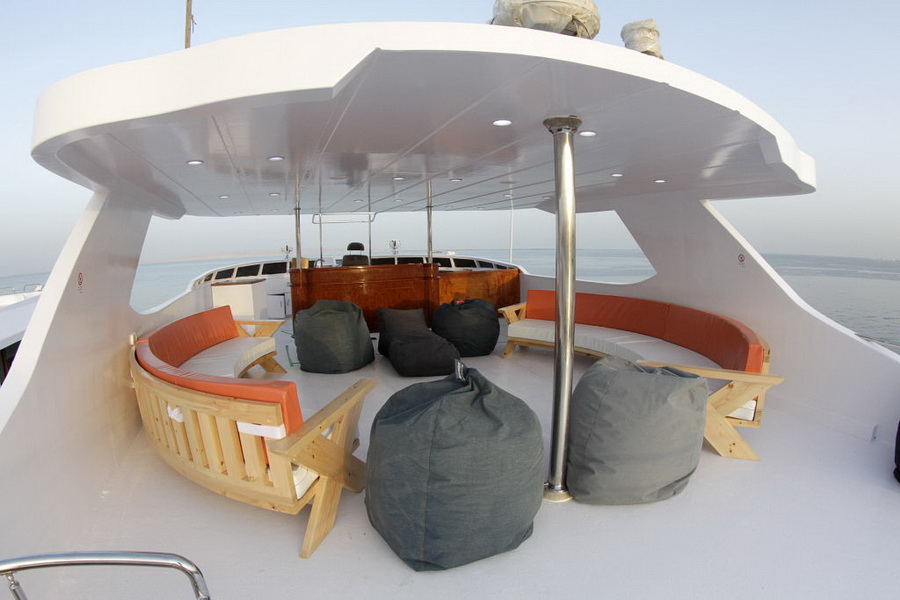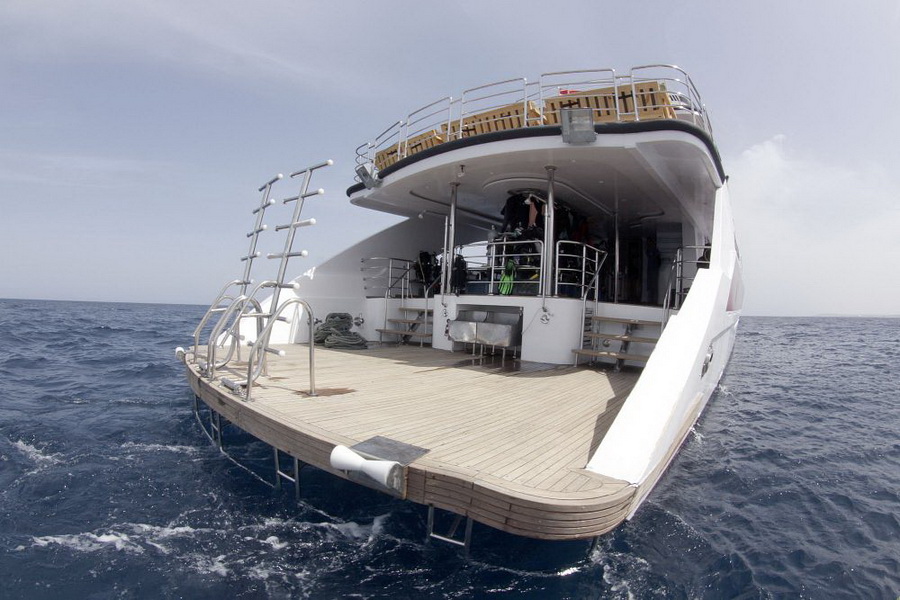Impressions: Emperor Elite
Équipement et détails
Spécifications techniques du bateau
Types de cabines & informations détaillées
Lower Deck Twin
Informations sur le type de cabine
Salle de bain
Main Deck Twin
Informations sur le type de cabine
Salle de bain
Upper Deck Twin
Informations sur le type de cabine
Salle de bain
Upper Deck Junior Suite
Informations sur le type de cabine
Salle de bain
Upper Deck Executive Suite
Informations sur le type de cabine
Salle de bain
Itinéraires et informations
Reefs & Wrecks
En savoir plus
Cet itinéraire présente le meilleur des deux mondes, où vous visitez des épaves célèbres dans le nord de la mer Rouge tout en faisant de la plongée sur des récifs magnifiques.
Le célèbre récif en forme de fer à cheval de Shaab El Erg est un parfait exemple des récifs proposés lors de cette croisière, avec son magnifique jardin de coraux durs et la possibilité de voir des dauphins.
Abu Nuhas compte quatre épaves bien connues : Le Giannis D, le Carnatic, le Chrisoula K (" épave de tuile ") et le Kimon M (" épave de lentille "), qui offrent tous des plongées spectaculaires et une grande richesse de poissons.
Entre deux plongées sur épaves, vous visiterez également les récifs du détroit de Gubal, du golfe de Suez et ceux situés au nord d'Hurghada. Une variété de murs profonds et de jardins de coraux durs avec une abondance de poissons de récif valent bien une visite.
Les plongées de nuit peuvent être superbes car l'île de Gubal offre un mouillage protégé pour la nuit. Une petite épave à 8-10 mètres de profondeur permet une plongée de nuit spectaculaire avec des poissons-lions, des poissons-scorpions et une murène géante, ainsi que l'épave de l'Ulysse. Ensuite, le Kingston se trouve à Shag Rock, le Carina près de Sha'ab Ali et le Dunraven à Beacon Rock.
Ras Mohamed, situé à l'extrémité sud du Sinaï, est l'un des parcs nationaux les mieux gardés d'Égypte. Ses eaux riches en nutriments, ses parois abruptes descendant jusqu'à 1000 mètres de profondeur attirent une grande quantité de gros poissons et lui valent la réputation d'être l'une des meilleures zones de plongée au monde. Pendant votre séjour, vous aurez peut-être la chance de plonger à Shark Reef, un mur abrupt tombant dans le bleu, ainsi que sur l'épave du Yolanda.
Jackson Reef, surnommé localement l'"Aquarium", est la plongée la plus populaire de Tiran. La "Jackson Drift" est la plongée en dérive la plus rapide et la plus exaltante de Sharm, le long d'un mur étonnant qui regorge de coraux prolifiques. De temps en temps, pendant les mois d'été, on peut apercevoir un banc de marteaux halicornes. Thomas Reef vous offre des murs plongeants couverts de corail mou, de gorgones et de poissons colorés. Le mur ouest est plus sombre, avec des surplombs et des grottes remplies de glassfish et de sweepers. Une plongée de nuit à Gordon Reef promet diverses espèces de coraux, de petits nudibranches cachés dans les crevasses et les coraux mous et une chance de voir des requins de récif à pointe blanche, des raies aigles, des pieuvres et différents types d'anguilles comme la murène, la murène poivrée et la murène à bord doré.
Enfin, l'épave la plus célèbre de la mer Rouge, le SS Thistlegorm, à Shaab Ali, avec une plongée de nuit sur le Thistle. Le Thistlegorm a été coulé en 1941 après avoir été bombardé par la Luftwaffe allemande alors qu'il était en mission pour livrer une cargaison de munitions et d'autres matériels de guerre aux troupes britanniques en Afrique du Nord. De là, le bateau repart vers Hurghada.
South & St Johns
En savoir plus
This trip takes you to some of the best diving the Red Sea has to offer. Here the diving is less arduous so it's a trip for those who want to see the best but have a more relaxed time while doing so. Sailing to the southernmost reefs, you'll depart from Marsa Ghalib Port and dive some sites to the South before sailing overnight to your southernmost point in the St. John's area. Depending on weather, government approval and marine life sightings in recent weeks, we may sail to the southernmost islands of Rocky and Zabargad, or we'll moor instead in the vast reef system of St John's to begin the adventure in the South.
When leaving Marsa Ghalib the route can sometimes take in a dive at Abu Dabab on the first or last day. Often spoilt for choice, your guides will pick sites that they know to be the best for the time of the year and can find excellent alternatives should the weather affect the normal route. Although the distances are long, where possible we travel overnight so, as a 21 plus route, our aim is to get as many dives in as possible at some of the most impressive reefs. Below are some of the highlights.
On the way to Fury shoals, dive Sha'ab Sharm with its wall dives and white tip reef sharks. Oceanic white tips and silky sharks can sometimes be found in the blue and turtles often visit the south side before heading further south. At Fury Shoals, dive Sha'ab Claude with its famous swim-throughs and huge porite corals. White tip reef sharks and an anemone and clownfish settlement can be seen a little off the reef to the South. Abu Galawa Soraya has a fantastic coral garden and a wreck of a private sailing boat populated with glass fish.
St Johns is a vast collection of small reefs offering some of the most remote and rewarding diving in the Red Sea. This incredibly beautiful reef lies a short distance north of the Sudanese border. The reef covers a huge area and many dives would be needed to explore the numerous coral heads and islands. Habili Ali offers giant gorgonians and black corals whilst grey reef, silvertip and schools of hammerhead sharks might be found on the west side. Habili Gafaar is a mass of soft corals teaming with shoals of snappers, butterfly fish and barracudas. Mantas, grey reef and silvertip sharks can often be seen in the blue.
Gota Kebir is a massive reef, famous for its tunnels and south plateau, where jacks and barracudas can be seen and the occasional manta. The tunnels are ideal for novice cave divers.
Gota Soraya is rated as possibly one of the best wall dives in the Red Sea, with overhangs and cracks in the reef wall full of glass fish and sweepers and an abundance of corals, Grey Reef, Silvertips and Hammerhead sharks.
On the last day as we head back to port, we will try to take in a dive or two on the world famous Elphinstone Reef if weather and diver experience permits us, or we will finish in the Abu Dabab area perhaps with another dive or two closer to Port Ghalib to relax and unwind before your final night in port.
Southern Solitude
Daedalus, Fury & Elphinstone
En savoir plus
This trip offers you some of the best diving in the Red Sea and includes Daedalus, Fury Shoals and Elphinstone. With less distance to travel than some routes, you have more time to dive these iconic sites and there is less chance of seasickness with shorter sailings and secure moorings. Depending on prevailing weather conditions your guides will pick sites suitable for night dives outside the Marine Park.
Heading first to Fury Shoals, we may dive around the Marsa Alam area or perhaps dive Sha'ab Sharm with its wall dives and white tip reef sharks. Oceanic white tips and silky sharks can sometimes be found in the blue and turtles often visit the south side before heading further south. At Fury Shoals, we have more time to explore the vast reef system than other itineraries afford. Of course we will dive the classics such as Sha'ab Claude (a.k.a. Claudio) with its famous swim-throughs and huge porites corals, Malahi with its mazes and friendly turtles and Abu Galawa Soraya with its fantastic coral garden and a wreck of a private sailing boat smothered with glass fish. Sataya with its resident spinner dolphin population is a must for snorkelling between dives, as well as having some good underwater offerings, and on top of that we can spend time exploring less dived sites such as Sha'ab Hamam (Stairway to Heaven), Abu Galawa Kebir with the Tien Hsing wreck, Gota Sataya and if the weather is kind there are some submerged reefs that can be moored on such as Habili Sameh that will blow you away!
Daedalus Reef, a part of the Red Sea offshore Marine Park, is a large, oval reef with a lighthouse and is the furthest offshore reef in the Egyptian Red Sea. Its deep walls and drop-offs offer some of the most spectacular diving to be found. Daedalus has mountainous, pristine, hard coral formations. There is also a strong chance of spotting schooling hammerheads, especially from May to November, and grey reef sharks.
Of course no trip to the South would be complete without stopping at world famous Elphinstone, with its sheer walls covered in soft corals, and likely encounters with oceanic white tip sharks. Depending on the experience of the group and the weather, you may even get the chance to dive it at the beginning and end of your amazing trip!
Simply the Best
En savoir plus
Dive the Best Top 3 sites in this area: Big and Little Brothers, Daedalus Reef and Elphinstone.
The Brother Islands are the pinnacles of two undersea mountains rising from the depths of the abyss and are located about 60 miles offshore. Part of the Marine Park Islands National Park, these islands offer stunning wall diving, with the walls being covered in soft corals and forests of gorgonians, creating a kaleidoscope of ever-changing colours. They attract a diverse array of marine species and large pelagics. Large tuna, jacks and snappers cruise in the blue, accompanied by occasional hammerheads, silvertips, silky and oceanic white tip sharks and mantas. Even the rare thresher shark can be found here. Sightings of the grey reef shark are almost guaranteed on the North and South Plateaux of Small Brother.
For the wreck diver, the Aida II, an Egyptian supply vessel, and the Numidia, a cargo ship, lie on the walls of the Big Brother. Both are covered in a rich growth of soft and hard corals. Marine life includes a family of Napoleon wrasse and grey reef sharks.
Daedalus Reef, also part of the Marine Park, is a large, oval reef with a lighthouse and is the furthest offshore reef in the Egyptian Red Sea. Its deep walls and drop-offs offer some of the most spectacular diving to be found. Daedalus has mountainous, pristine, hard coral formations. There is also a strong chance of spotting schooling hammerheads and grey reef sharks.
Elphinstone, with its sheer walls covered in soft corals, offers a likely encounter with oceanic white tip sharks.
Safaga, Brothers & Elphinstone
En savoir plus
The area around Safaga has some great diving, the best being the offshore reefs of Panorama Reef, Middle Reef and Abu Kafan. Some divers say this area equals the great sites of Ras Mohamed. The diving offers a combination of shallow reef dives and drop-offs, as well as the famous wreck of the Salem Express. The Salem Express is a dramatic dive. Around 500 people perished in one of the worst marine tragedies of all times. The 100-metre ferryboat was on its way back from Mecca to Safaga after the annual Muslim pilgrimage in December 1991 when it hit the reef during a stormy night and sunk rapidly without giving the crew and passengers the chance to board the lifeboats. It is now home to a thriving underwater life, including a famous resident frogfish, blue-spotted stingrays, angel and butterfly fish. The ship itself is covered in a large quantity of hard and soft corals. It is one of the largest wrecks in the Egyptian Red Sea, roughly the same size as the Thistlegorm. There is superb wall diving at Panorama, on the south-east of the plateau is a gorgonian and glassfish corner with the whole plateau covered in soft corals and on the south side is an anemone city. Hal Hal (Middle Reef) is a rarely chosen dive site due to its distance from the coast, which makes it a virgin spot. The north side is a drop off going down to 80 metres and is a perfect location to spot tunas, barracudas, turtles and sharks. The southern side has colourful coral gardens along with some caves and canyons. Abu Kafan is a 300-metre long, narrow reef offering a plateau at both north and south tips. We normally jump in the water on the north plateau and glide with the frequent strong current southwards along the impressive walls covered with soft and black coral, giant fans and gorgonians. The Brother Islands are the pinnacles of two undersea mountains rising from the depths of the abyss and are located about 60 miles offshore. Part of the Marine Park Islands National Park, these islands offer stunning wall diving, with the walls being covered in soft corals and forests of gorgonians, creating a kaleidoscope of ever-changing colours. They attract a diverse array of marine species and large pelagics. Large tuna, jacks and snappers cruise in the blue, accompanied by occasional hammerheads, silvertips, silky and oceanic white tip sharks and mantas. Even the rare thresher shark can be found here. Sightings of the grey reef shark are almost guaranteed on the North and South Plateaux of Small Brother. Abu Dabab is six reefs commonly known as "Fathers Steps" or "Fathers Stepping Stones" and as the name suggests a set of fairly shallow reefs ranging from depths of 25 metres to the seafloor. In between Abu Dabab II and III at approximately 15 metres is the wreckage of a small ship sunk after a fire in 2004. The reefs themselves offer colourful coral gardens and an underwater cave system to explore. Pods of dolphins have been known to frequent the area as well as blue spotted rays, Napoleons, giant puffers, box fish, sweetlips, batfish, nudibranchs and more. Elphinstone is approximately 30km from Port Ghalib; Elphinstone reef is 300 metres long with sheer walls richly covered in colourful pink and red soft corals and elegant red gorgonians descending to around 40 metres. Other areas of the reef have near vertical cliffs, overhangs, small caves and drop offs of up to 100 metres. Elphinstone is known to experience some strong currents attracting many diverse species such as barracuda, angel fish, groupers, Napoleons, morays, reef sharks and great shoals of dogtooth tuna and jacks. Occasional sightings include dolphins, turtles, oceanic white tip and hammerheads sharks.


